With a full moon in the sky last night was a test session for my new IR block filter and the Geoptik Canon lens adapter. Back focus is at a premium with this system with only 7-8mm to squeeze a filter into. The new filter appears to be slightly too thick but was within a whisker of achieving focus so there may be hope yet. Swapping the filter out I refocussed on Sadr and took 10 3 minute exposures at 135mm. A heavy crop of the field removed the worst of the background gradient introduced by the moon but some artifacts of this remain after processing.
Category: Nebula
The Veil nebula is something I’ve been meaning to take an image of since I got my QHY9 camera and last night was the first opportunity I’ve had. The skies are getting dark again after the summer twilight, there was no moon and conditions were pretty much as perfect as they’re going to get in the UK.
Using the Canon 75-300mm lens at a focal length of 100mm I took 20 5 minute exposures followed by 30 2 second flat fields. This lens is badly afflicted by vignetting and the flats compensate nicely. With Cygnus high in the sky and little moisture to reflect the ever present light pollution gradients weren’t a problem for this wide field.
The nebula doesn’t stand out particularly well against the backdrop of Milky Way stars in this image. To improve visibility, I’ve cropped the image fairly tight to the nebula as otherwise it’s rather lost amongst the stars.
Some night sky objects are truely huge. The problem is that they’re hard to observe as their surface brightness is low and they require a large wide field telescope and a very dark sky to actually eyeball them. One such object is Sharpless 220, a.k.a. NGC 1499, a.k.a. The California Nebula in Perseus. This extends almost 2.5 degrees, or about 3 moon widths.
This picture was taken with a Canon 75-300mm zoom lens mounted on my QHY9C. Focal length was 135mm providing a 7.7 x 5.7 degree field. 12 5 minute exposures were combined and the light pollution gradient removed with GradientXterminator.
Treasures in Auriga
This week has been a surprise with clear nights and no moon, albeit rather hazy. Having missed sunday evening, monday evening took a while to clear and Auriga was getting rather low by the time I started imaging. However, before it dropped into the haze I got 30 minutes worth of the area around IC405 and IC410 using 3 minute exposures.
The next opportunity was on wednesday and with the skies clearing earlier in the evening I added another 90 minutes of exposures. It helps that the central cluster is so bright which makes centring the image easier.
One image had a satellite trail so here’s the result of stacking the remaining 44 frames.
 Telescope: WO Zenithstar 70 with FFIII
Telescope: WO Zenithstar 70 with FFIII
Camera: QHY9C
Mount: Astrotrac
Sunday night was going to be a wide-field night using my Sigma 10-20mm zoom attached to the QHY camera. Things didn’t go to plan. The issue was focusing again. I’d cracked this on the 75-300 zoom but the Sigma is very fussy about back focus. A 10mm extension tube put the focus point beyond infinity and a 5mm tube was equally unsuitable at the other end of the focus range. So, I need something between the two but ideally it needs to be adjustable as well. Back to the drawing board.
With that plan axed for the night I put the Zenithstar 70mm on the mount and in the time remaining before Orion disappeared behind a tree took 90 minutes worth of 3 minute exposures of the region around Alnitak.
The Rosette nebula
Monday evening was the clearest of the year so I put the Zenithstar on the Astrotrac with the QHY9C and pointed it towards the Rosette nebula. The central cluster was an easy binocular object and using the red-dot finder the telescope was pointed without difficulty.
While the polar alignment looked reasonably accurate there was some drift in RA that I will need to eliminate. Cable drag is one possibility I’ve looked at before but I suspect that the Astrotrac is tracking at the wrong rate and may require recalibration.
Trailing was quite pronounced on 5 minute exposures but I took 19 images of this length.
With the purchase of an additional 15mm extension tube I was ready for a clear night and Sunday night delivered. I got the 9.25″ setup on the CG-5 relatively quickly and found that with the additional tube both cameras were able to focus. M78 is something I’ve wanted to image for a while so after aligning the mount a goto put the twin stars of the nebula in the field of view.
The big problem was finding a guide star in this region. I found that putting a wide field eyepiece in for an initial look is a good time saver and, having found a star I replaced the camera and set it for 2 second exposures for guiding with PHD.
Initial attempts at 5 minute exposures were unsuccessful so I dropped these to 3 minutes and set the QHY running for 2 hours worth. Despite some fairly erratic guiding graphs I was surprised at the quality of the images and only had to throw 2 for non-round stars and one for a satellite trail.
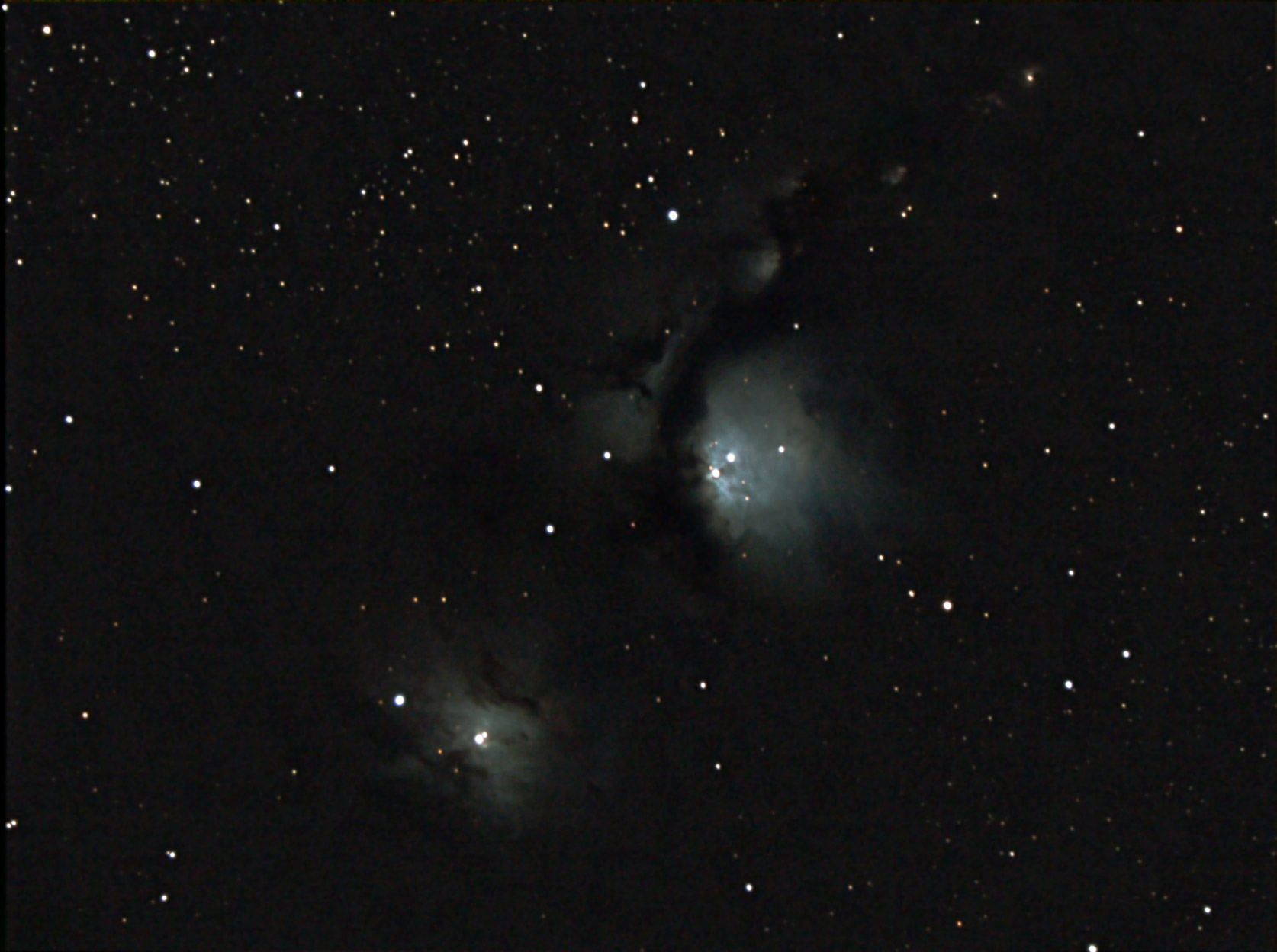 M78 is part of a larger nebula complex in Orion with M42/43 the most prominent component. It is the only principle reflection nebula in the Messier catalog. McNeil’s variable nebula is bright and visible towards the top right of the image.
M78 is part of a larger nebula complex in Orion with M42/43 the most prominent component. It is the only principle reflection nebula in the Messier catalog. McNeil’s variable nebula is bright and visible towards the top right of the image.
For another reflection nebula, check Dan’s post here: http://farawaythings.blogspot.com/2011/12/perseus-cloud.html
One of the things I’ve been planning to do for some time is getting an auto-guider working with the club CG-5 mount. I had plans for the old Starlight-Xpress camera but it’s just to heavy for the off-axis guider to support. The purchase of an Imaging Source camera by the club has re-opened the possibilities here.
A clear, moonlit night provided a perfect opportunity to get this setup and I put the Celestron 9.25″ on the mount with the guide camera and my QHY-9C hanging off the radial guider on the back. What became clear pretty quickly was that I couldn’t get both cameras into focus at the same time. I was short of about 15mm of T2 tube on the QHY. The rest of the testing appeared to run OK though so I’ll just need to obtain a new extension tube before I can try again.
As I’m always reluctant to pack up without imaging anything I turned the telescope towards M42 in Orion for some 30 second unguided frames. 10 were stacked and processed for this picture.
Last night we had some visitors from Hingham Primary School at the observatory. During the evening the sky was steadily improving and they enjoyed some fine views of Jupiter.
Once they’d gone then I turned my attention to taking some pictures of the dark nebula B33 in Orion which was by now a good height from the horizon. I’ve said this before but it will bear repeating; if you want to take longer exposures on the 20″ wait until the target is rising in the East. Frame rotation is at it’s lowest, the telescope tracks and guides best in this direction and you’re going to be troubled less by car headlights.
I took 22 60 second exposures with the Atik camera, binned 1×1 and all were acceptable in terms of star shape.
Our old friend the Bubble Nebula in Cassiopeia again, this time on the society’s 20″ with the ATIK 383L camera.
By the time I was imaging this, it was almost at the zenith with all the issues that brings when using the Alt/Az dobsonian. Can anyone say ‘field rotation’?
This image is a stack of 30 second LRGB frames. Luminance are binned 2×2 and the colours 4×4.



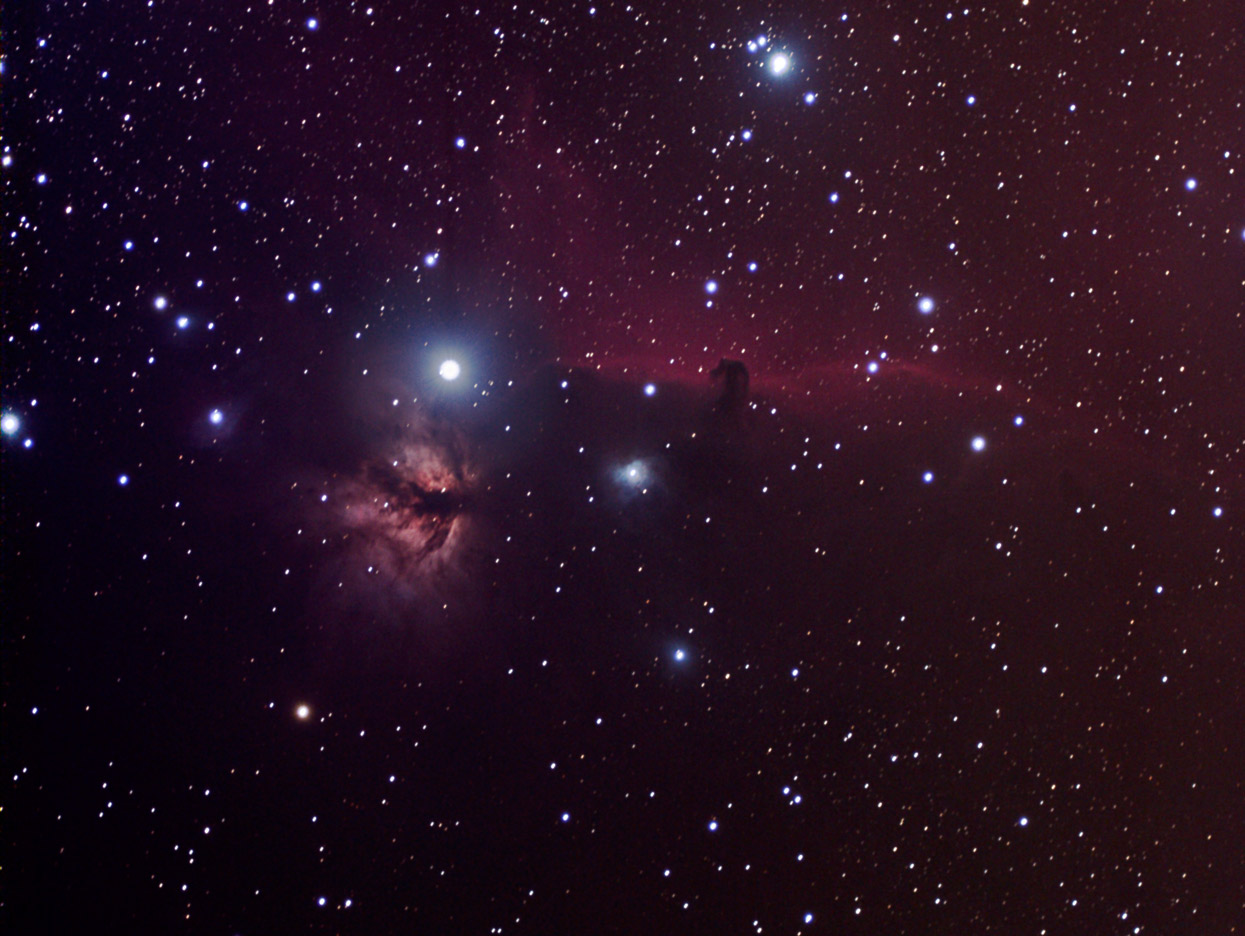
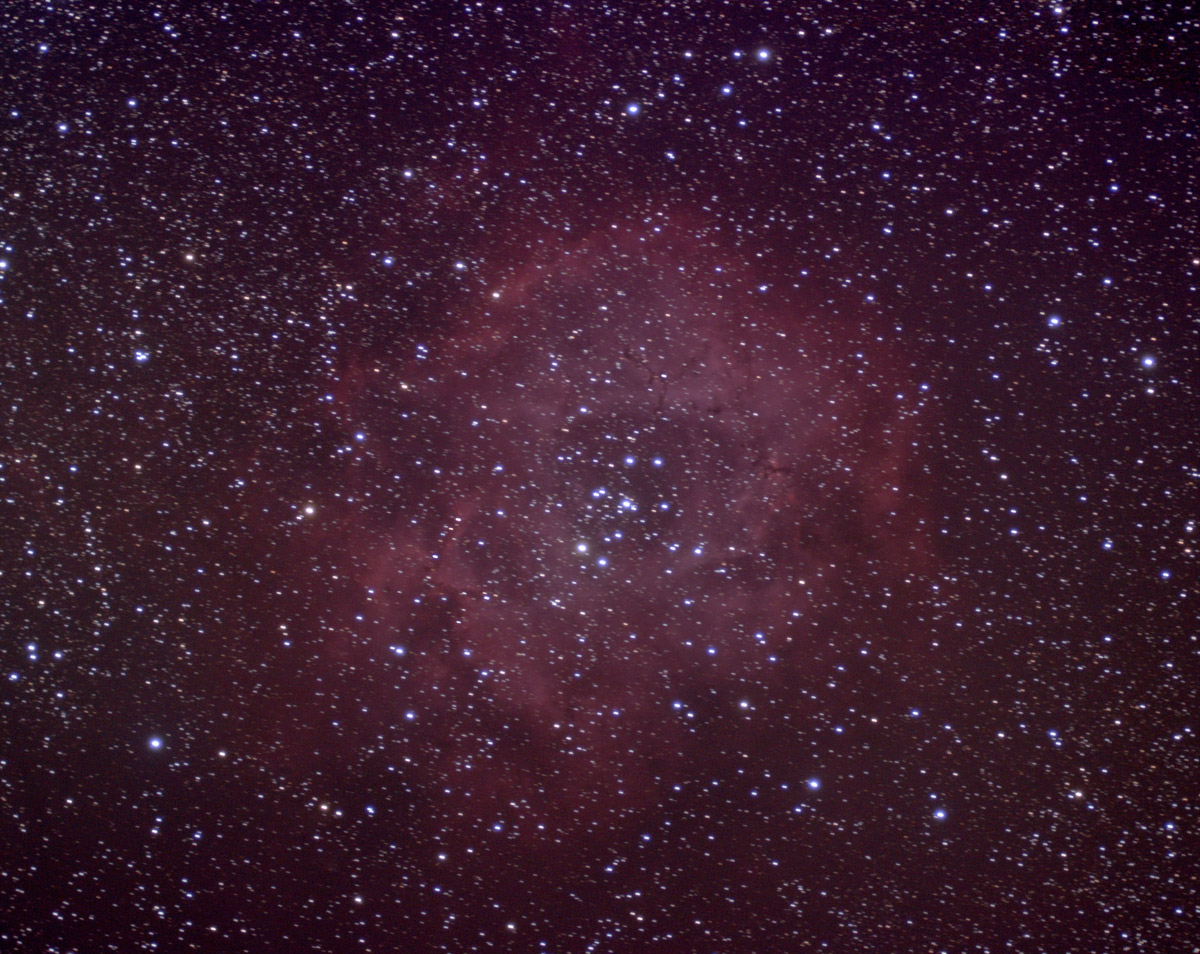
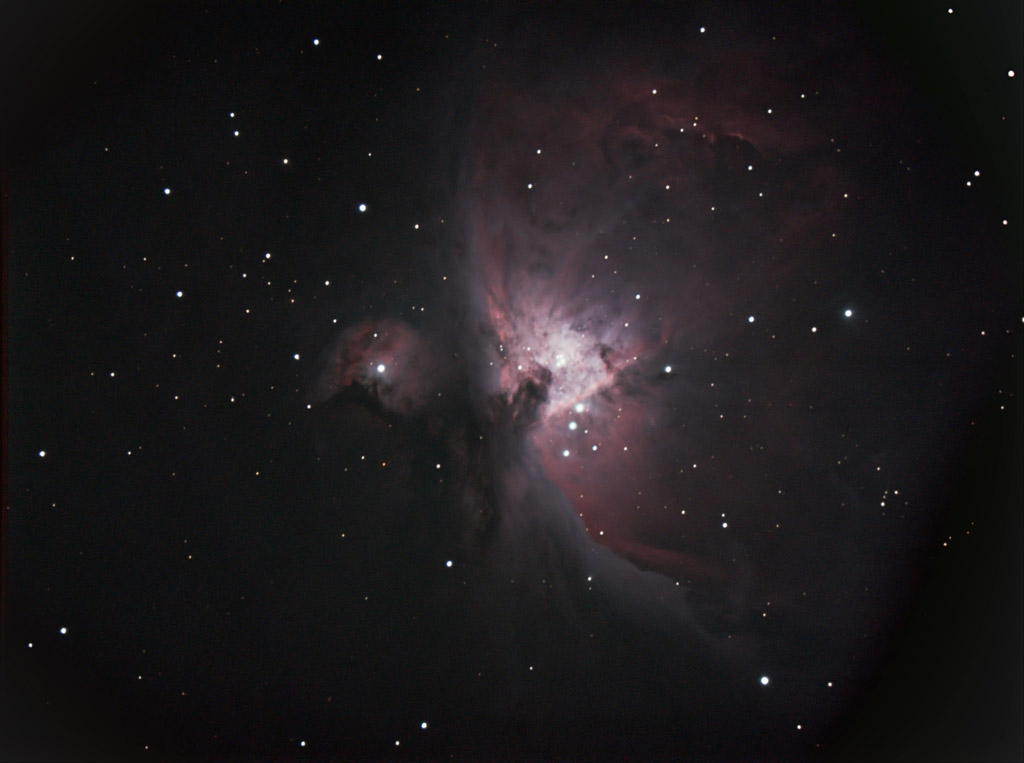
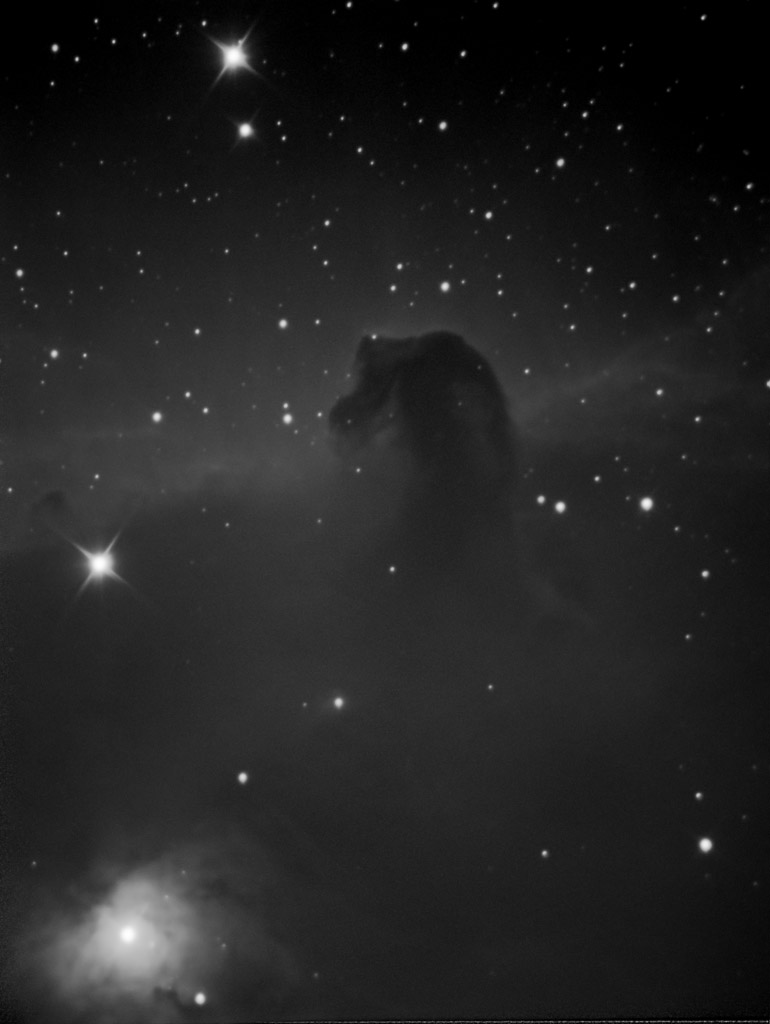

![ngc7635[1]](http://andrewluck.me.uk/wp-content/uploads/2011/10/ngc76351.jpg)